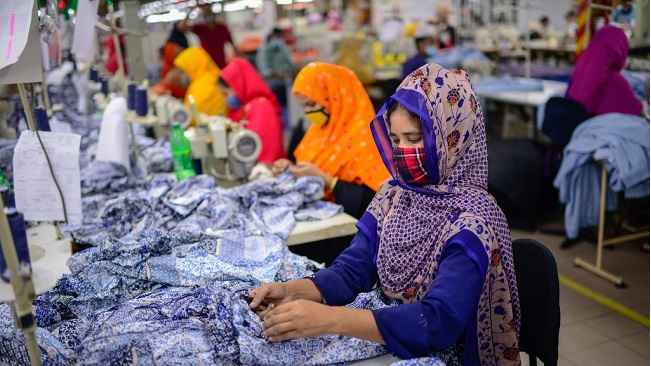Bangladesh’s RMG exporters are seeing profits shrink as buyers increasingly control pricing through open costing, which has grown from 10% to 60% of total exports over the last decade. This pricing method is making it harder for factory owners to stay profitable, with some even facing financial losses.
What is open costing?
Under open costing, buyers determine product prices based on a transparent breakdown of production costs, including raw materials, labour, overhead, and profit margins. This system gives buyers greater control, but factory owners say it does not account for unexpected costs, such as sudden supply chain disruptions, delays in raw material supply, being forced into underhand dealings, or unexpected labour unrest that shuts down factories – all of which increase production costs.
Factory owners speak out
Inamul Haq Khan Bablu, Managing Director of Ananta Garments, said due to open costing, profit margins have completely decreased. Even a slight deviation here and there leads to losses, because since buyers nominate factories for most of the raw materials, there is no way to deviate from that.
He said that in 2023, his company lost Tk4.5 crore due to vandalism and arson during labour unrest at their Gazipur factory. More factory closures in Ashulia added to the losses.
Shovon Islam, Managing Director of Sparrow Group, which exports $300 million worth of garments annually, said 70% of their orders are priced through open costing. He described it as “walking a tightrope”, as it assumes stable production conditions – something that is often unpredictable in Bangladesh.
Low profit margins and competitive pressure
Garment exporters say intense competition among factories in Bangladesh is further weakening their ability to negotiate prices.
They say they are currently only given a profit margin based on the cost of making, which ranges from 1% to 4%.
They further add that in open costing, buyers also factor in various tax and cash incentive benefits provided by the government to RMGs, meaning these benefits are not reaching the exporters but are instead ending up in the buyers’ pockets.
The other method of price determination is known as Freight on Board (FOB) pricing where prices include different cost factors; open costing does not allow extra profit from raw materials and accessories.
While open costing is used globally, factory owners argue that in India, Vietnam, Thailand, and Cambodia, it works better because these countries have higher profit margins and fewer disruptions.
Shovon Islam says, “In most cases, around 60% of the product’s inputs must be sourced from the buyer’s nominated suppliers. The remaining costs also need to be disclosed to the buyer. On this, a maximum of 3% profit margin can be made.”
Open costing involves large bulk orders
Entrepreneurs say large bulk orders are primarily priced using this method. Major brands that source large quantities from Bangladesh include Inditex, H&M, Marks & Spencer, Primark, C&A, Walmart, Gap Inc, and Uniqlo.
In FY24, Bangladesh exported nearly $36 billion worth of apparel products, including home textiles. Among these, H&M stands out as the largest single brand, sourcing nearly $3 billion annually from Bangladesh.
Shovon Islam said, “Typically, orders over 1 lakh pieces are priced using open costing. Since large buyers place large-scale orders, they adopt this approach.”
He further mentioned that at least 120 large factories in the country supply orders based on the open costing method.
He also pointed out that it is not high-value or specialised apparel, but rather low-cost basic items like basic denim, T-shirts, polo shirts, etc, that are most commonly priced using open costing. “Since Bangladesh primarily produces basic items, we are at a disadvantage when it comes to pricing.”
Do buyers lower prices even further?
Several exporters say sometimes buyers do not even want to pay the price determined through open costing.
Fazlee Shamim Ehsan, chief executive officer of Fatullah Apparels Limited, told TBS, “Let’s say, under open costing, the price for a T-shirt is $1. However, instead of placing the order at this price, the buyer will then approach four more suppliers, asking if they are willing to accept a lower price through a tender process.
“Some may agree to take the order at $0.98, others at $0.96, and ultimately, the lowest bidder will win the order.”
This race to the bottom puts more pressure on exporters. Explaining why they accept orders at such lower prices, he said, “Some factories have excessive capacity. When there is little work, the risk of losses due to wages, overhead costs, and other expenses increases. To reduce these losses, factories may take orders at break-even points or even at a loss.”
The Fair Wear Foundation, an organisation focused on ethical garment production, says brands must take responsibility for fair pricing and improve transparency in open costing.
TBS reached out via email to H&M, Walmart, and Gap Inc to inquire about the percentage of sourcing from Bangladesh and the allegations of low pricing on Bangladeshi garments. While H&M responded to the email, the brand declined to share the information due to business confidentiality.
“The open costing method is in place in all our sourcing markets. Bangladesh is one of our largest production markets and we are committed to developing responsible purchasing practices in place that ensure we are a fair business partner to our suppliers,” H&M Group replied.
Can exporters unite to raise prices?
Factory owners say “unhealthy competition” among local exporters is making it easier for buyers to push prices down. They see setting standards for price increases and maintaining unity among suppliers as a solution.
An RMG company’s managing director, speaking on condition of anonymity, told TBS, “If all factories decide to raise prices by 10%, buyers would not leave Bangladesh.”
He added that despite rising costs, Bangladesh remains one of the cheapest garment suppliers – but exporters still accept orders at a loss.
Data from UK Trade Info indicates that during the January-October period of 2023, the average price of apparel products exported from Bangladesh was 21.39% lower than those from China, 32% lower than those from Turkey, and 26.75% lower than those from India.




















